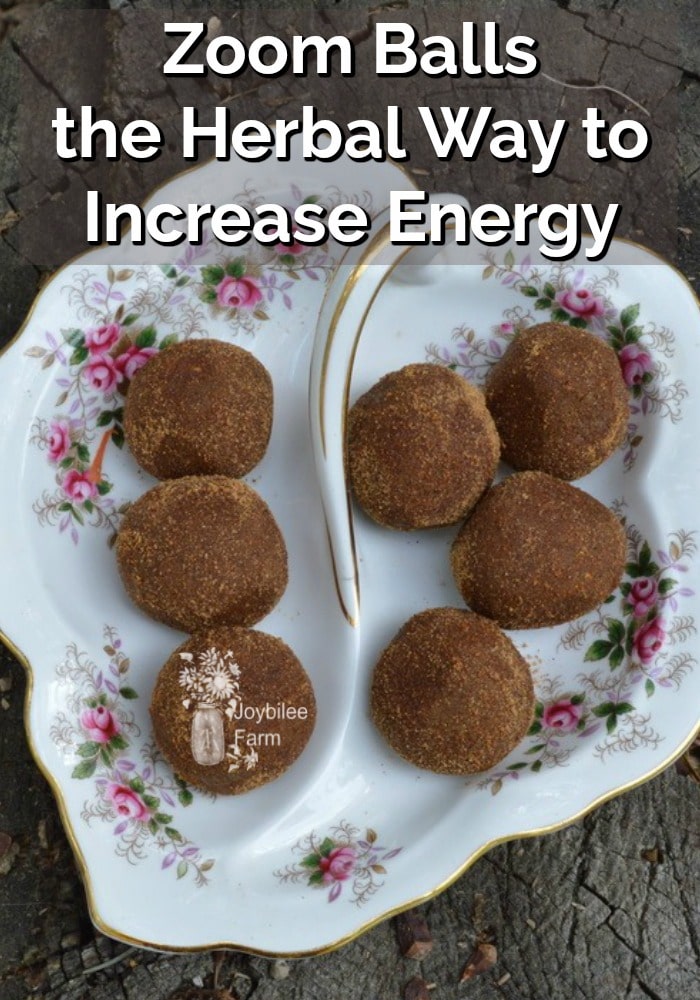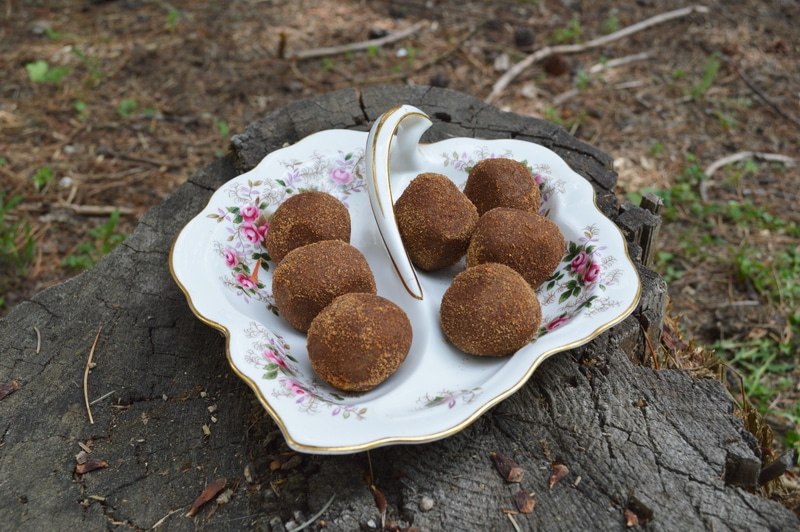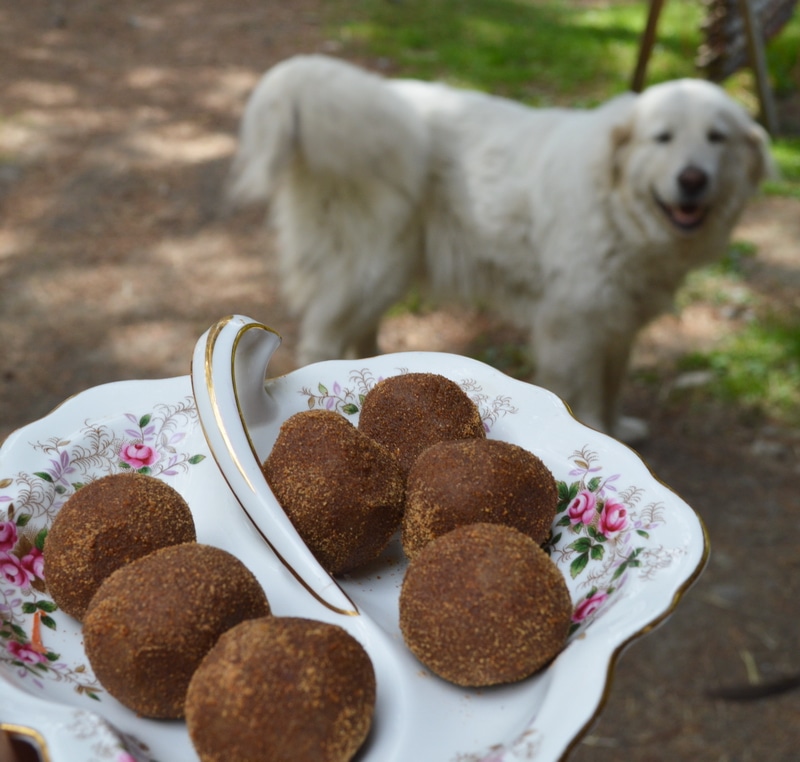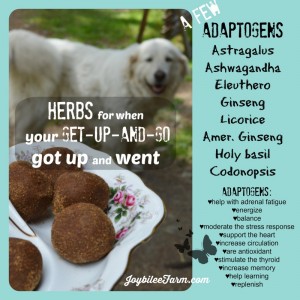Zoom Balls, a recipe that utilizes adaptogen herbs to help the body adapt to stressful situations and restore its vital energy.

Stress has a payday
Have you noticed how our culture glorifies stress? People even encourage the release of stress hormones in their bodies by watching scary movies, jumping out of airplanes or off cliffs, or watching other people do these things, listening to loud music, watching sports, or working lots of overtime. There seems to be an addiction to the stress hormones in our culture. But it can’t be lasting. Eventually, you have to pay the piper.
This spring has been especially difficult for me. I’m tired. Maybe not burned out exactly, but the heavy, slow feeling that followed me around all winter hasn’t left me with the snow like it usually does. I seem to be catching everything that’s going around. I tire more easily. I feel chilled and damp, waiting for something that never seems to arrive. Maybe it’s summer’s warmth.
It didn’t happen suddenly. It slowly crept up on me, like my age – 55 at this reckoning. So I might think it’s just middle age spreading its heavy, wet blanket over me, smothering my vital spark. But it isn’t just me.
My friend, in town, just a tad older than me, has been complaining of adrenal fatigue. An avid gardener and enthusiastic volunteer, she’s lost her core fire. And then there’s my best friend. Mr. Joybilee is stressed past the point of rebound. He’s been in the hospital twice in the last 14 months due to stress, and the diagnosis – low blood pressure with adrenal fatigue.
The interesting thing about adrenal fatigue is that there is no drug that can fix it. There’s no pill to refill your adrenal glands. The usual prescription is moderate exercise, eat a balanced diet, relax, and get adequate rest – lifestyle changes. But what do you do if you already do that and you are still stressed and exhausted? Mr. Joybilee says, “drink coffee.” But coffee is a stimulant that actually steals from your already depleted adrenal glands. So, while it might appear to get you through a day at the office, that’s not a healthy long-term solution.
Learning about herbs
In May, I started the Intermediate Herbal Course at the Herbal Academy of New England. In the course, I’m learning about anatomy and physiology in a holistic way. I’m finding out about different actions that individual herbs have on the body and which herbs are usually used for which health problems. It’s a fascinating study that fits right in with my passion for gardening, herbal remedies, natural dyes, and self-reliance.
I learned a few secrets in the course about the adrenal glands and about a special class of herbs called adaptogens. Adaptogens help nourish the body’s adrenal glands and restore that inner fire. This information alone was worth the price of admission!
The adrenal glands
The adrenal glands are two little glands that sit on top of each kidney. Their function in the sympathetic nervous system is to help the body cope with stress, by releasing the stress hormones norepinephrine and epinephrine. These are the hormones responsible for the fight or flight response that you’ve heard about in relation to stress. When these two hormones are released in the body, your blood vessels narrow, speeding up your heart rate and increasing your blood pressure. Glycogen is broken down in your liver, releasing more glucose into your bloodstream to fuel your flight from danger. There is also an increase in brain function as epinephrine helps the brain use up more glucose than it normally does.
The adrenal glands also release the hormone cortisol. Cortisol increases the function of the immune system for an hour after a stressful situation, in order to resist infection, trauma, or bleeding. However, after the first hour, there is actually a decrease in the function of the immune system, as the body makes less of its special immune cells like T-cells and macrophages. This decrease in the function of the immune system leaves you open to “catching everything that’s going around.” But that’s not the worst of it. Sex hormones, like testosterone, progesterone, and estrogen also decrease in the presence of cortisol. Less calcium is absorbed in the stomach. Well, actually less of everything is absorbed from your food, because during stress the parasympathetic nervous system shuts down, and food doesn’t get digested well. You can imagine the problems that can arise in a body that is chronically stressed.
Problems for the chronically stressed:
- Stomach pain, constipation, colitis
- Infertility
- Impotence
- Diabetes
- Cancer
- Heart disease
- High blood pressure
- Stroke
- Weight gain
- Osteoporosis
- Cavities
- Depression
- Anxiety
- Mental Illness
- Alzheimer’s
- Weakened immune function
What’s an adaptogen?
The adaptogen herbs nourish the adrenal glands while they tone the whole body, and help the body adapt to stressful situations. They help the body recover more quickly from stressful situations. They also nourish and rebuild the body, restoring its vital energy and helping it recover from chronic stress. Many adaptogens strengthen the immune system as well. And some are rich in antioxidants, removing free radical damage from the body. Doesn’t that sound like a class of herbs that we all need to know better?
Imagine my delight, when I was reading through Unit 2 of the Intermediate Herbal Course and came across the recipe for Zoom Balls, a recipe that utilizes adaptogen herbs, to nourish your inner fire. This is a simple recipe, inspired by Rosemary Gladstar. (Her original recipe for Zoom Balls is on page 37 of Herbal Recipes for Vibrant Health (Storey pub., 2008))
Rosemary Gladstar’s Herbal Recipes for Vibrant Health: 175 Teas, Tonics, Oils, Salves, Tinctures, and Other Natural Remedies for the Entire Family
Herbal Ingredients in Zoom Balls to rebuild your adrenal glands
Astragalus, an adaptogen, is an energizing tonic herb that builds immune strength and strengthens your spleen and lungs. It is a supertonic herb that treats imbalances. Astragalus stimulates the rebuilding of bone marrow, and it treats and prevents long-term infections, colds and flu. It promotes circulatory health and stimulates the regular metabolism of sugars. Herbal actions include adaptogen, immune stimulant, diuretic, vasodilator, antiviral.
Eleuthero, also called Siberian ginseng, is an adaptogen. It stimulates male virility, increases endurance and stamina, revitalizes and rejuvenates nerves, and emotions. Rosemary Gladstar says of Eleuthero, “This is one of our best herbs for increasing endurance and stamina and for building and enhancing our resistance to stress factors, whether emotional, physical, or psychological.”
Ashwagandha, also known as Indian ginseng, is another adaptogen. It increases the body’s ability to deal with stress, increases memory, and facilitates learning. It’s good for those times when you can’t seem to remember and thinking seems thick. It is an energizing and soothing, male tonic that restores energy. It is an immune stimulant, nervine, and antispasmodic. It is from the solanum family – like tomatoes and potatoes and the leaves are poisonous, it is the root that is used in herbal medicine. If you grow your own, harvest the root in the fall and compost the leaves.
Licorice is an outstanding tonic for the endocrine system. It is an adaptogen that builds the adrenals. It helps the lungs, soothes sore throat and cough. It is anti-inflammatory, demulcent, tonic, expectorant, and antispasmodic. Licorice is a catalyst and enhances the actions of other herbs in the formula. It is also sweet tasting. In this recipe, it is not overpowering, so if your loved one doesn’t care for licorice, try it anyway. It is an important catalyst in the recipe. However, it is only 6% of the recipe, so could be omitted.
Safety note: Licorice can induce a drop in potassium, leading to high blood pressure, weakness, and eventually congestive heart failure. Those with high blood pressure, heart, liver, and kidney disease, diabetes, and pregnant women should not use whole licorice.
Ginger powder is an excellent all-around tonic. It is a warming catalyst that enhances the other herbs in the recipe. Its flavour is noticeable in the recipe. It is a reproductive tonic, promotes circulation, improves digestion. It is antibacterial, antiemetic, antifungal, anti-inflammatory, antispasmodic, antitussive, antiviral, carminative, and a synergist. It enhances the action of other herbs in the formula.
Cardamon — Warming and drying, cardamom is useful for gas, bloating, nausea, lack of appetite, colic, diarrhea, headache from indigestion, and digestive upset, especially the kind caused by stress. Cardamom is also expectorant and anti-fungal.
Although not in the original recipe, I added Hawthorn berry powder for its good effects on circulation and the heart. Since Mr. Joybilee is struggling with low blood pressure, hawthorn seemed a good addition. Hawthorn tones the heart improves circulation balances blood pressure and maintains healthy cholesterol levels. It’s also a good antioxidant to fight free radical damage.

Zoom Balls (no-cooking required) Recipe
Zoom Ball recipe adapted from unit 2 of the Introductory Herbal Course
Ingredients
¼ cup astragalus powder
¼ cup eleuthero powder
¼ cup ashwagandha powder
¼ cup hawthorn berry powder
1 tablespoon licorice powder
1 tablespoon ginger powder
1 tablespoon cardamom
3/4 cup tahini (sesame butter)
1/2 cup raw local honey
1 tbsp. extra hawthorn berry powder to roll the zoom balls in.
Directions
In a large bowl, mix together the tahini and raw honey. In a second bowl, stir together all powdered herbs. Using a stand mixer with a beater paddle, slowly mix the powdered herbs into the honey/sesame mixture until thick paste forms.
Roll this “dough” into balls about 1 inch in diameter, in your hands. Roll the formed balls in 1 tbsp. of extra hawthorn berry powder. Place the formed balls in an airtight container. I used a 750-gram yogurt container with a lid to store mine. This recipe makes about 24 zoom balls.
Store in the refrigerator. They will firm up once they are chilled. Eat 2-3 daily.
Where on earth do you buy ashwagandha or eleuthero for making Zoom Balls?
I made these zoom balls for Mr. Joybilee, to help him cope with the severe stress he is under. I purchased all the ingredients to make this recipe from Mountain Rose Herbs in Oregon. The certified organic, powdered herbs purchased from Mountain Rose Herbs have a smooth, fine texture with no lumps. This makes a better-textured zoom ball. The ashwagandha that I ordered was the broken root, as they were sold out of the powdered root, at the time of my order. I ground the bits of the root in my coffee grinder, but I could not get them as fine as the commercially powdered roots. There are small chewy bits of ashwagandha in my zoom balls. So definitely, buy the powdered herbs for this recipe, if you can.
When should I eat Zoom Balls?
Definitely eat these in the morning rather than right before bed. They are invigorating and will increase circulation and energy. These are meant to be eaten for several weeks before you notice significant changes in your energy levels. They are nutritious, as well as strengthening.
Do I have to use sesame seeds in Zoom Balls?
You could substitute other nut butters for the tahini. I chose tahini because it is high in calcium. Maple syrup could be substituted for local honey. You could also add dark chocolate bits or dip the zoom balls in dark melted chocolate for an extra treat that is high in antioxidants.

Let me know how they turn out for you. My 32nd anniversary is next week and I plan to make a second batch, dipped in dark chocolate to celebrate.
Want to join me in this amazing class?
Want to know more about using herbs to help you and your family live your best life? Check out the two herbal classes at the Herbal Academy of New England. They even have a payment plan to make the courses affordable for everyone.
Check out the course syllabus here:
References:
Philip Fritchey. Practical Herbalism. Whitman Publications, 2004.
Rosemary Gladstar. Herbal Recipes for Vibrant Health. Storey Pub., 2008.
David Hoffman. Medical Herbalism. Healing Arts Press, 2003.
Matthew Wood. The Practice of Traditional Western Herbalism. North Atlantic Books, 2004.
The Intermediate Herbal Course unit 2 and unit 5




Absolutely.
This looks like a great recipe! Currently, I’m not eating nuts or seeds and am wondering if I could mix the powders with dates to keep it vegan and nut/seed free.
Can I leave out the Valerian /Ashwaganda? or make two recipes one for morning and one for nightime?
I am interesting in recharging my adrenals for constant stress.